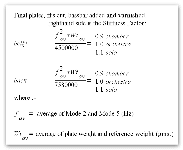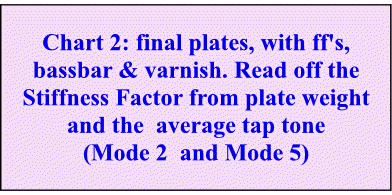|
David Langsather gives low plate weights of 54 gm front with bass bar, and an incredible 86 grams back. Stradivarius' bellies, with bass bar & varnish, are also typically low at 58 - 70 gm. Dr. Harris uses heavier plates, typically 65 gm front and 109 gm. back before ff's and varnish.
A Charles Davis has been in touch to tell me (Jun08) about Joseph Curtin's Strad magazine article on Stradivarius front plates: found at the Strad magazine website. Based on these (obviously) finished Italian violin bellies I suggest the front's target ‘stiffness figure' is 4.5x10E6 (i.e. just 12.5% or ~0.7 of a semitone above raw plates) for a finished belly or violin front plate. Chart 2 (see below) incorporates these figures.
Matching the plates: Matching Stiffness Factors!
It's important that the “Stiffness Factors” of the front and back plates match for a good instrument. The general rule seems to be that the front ‘s stiffness factor should be equal to or not more than 15% less that of the back.
Finished plates: the front or belly with ff holes, bassbar & varnish, and the back varnished.
Based on the good old Italian fronts of Joseph Curtin's Strad article then final varnished violin fronts should have a ‘Stiffness Factor' some 12.5% or about 0.7 of a semitone higher than the raw plate, and this is shown in Chart 2 below.
Cutting the ff holes in a raw belly plate lowers Modes 2 & 5 frequencies. Then adding the bassbar and varnish raises them again. If there is no “final tuning”, i.e. thinning the belly a little from the ‘raw plate' tuning, then typically the plate stiffness would be 10% to 15% higher than the ‘raw plate, tying up with a Stiffness Factor of a raw belly plate (no ff's, bassbar or varnish) of 4,000,000. Varnish will harden too over the first year an more, raising Modes 2 & 5 slightly with time. The back is only slightly affected by varnish.
As before for the ‘raw' plates before the ff's are cut and bassbar put in, a similar relationship applies:-
The average of the Modes 2 and Mode 5 tap tones (in Hz) still needs to be modified somewhat to take account of the plate's weight, and what sort of ‘tone' you want from the instrument.
So for an 'orchestral' tone (see below) the final plates need to have a stiffness factor of :-
- about 4,500,000 for the front, with its ff's, bassbar & varnish, calculated, or a Stiffness Factor of 1.0, and
- 7,580,000 for a good maple back plate that is varnished, calculated as above.: a Stiffness Factor of 1.0 again.

To avoid the maths, use the chart (left) that allows the ‘Stiffness Factor' for both a front (belly) and back plates in final varnished state to be derived directly from:-
- the average tap tone, i.e. the average of Modes 2 & 5, typically 260 Hz, and
- the plate's final weight: e.g. 109.3 grams for a back, and e.g. 64.7 grams for a belly with bassbar, ff's and varnish.
I use a pocket calculator to derive the average plate freq. from the Modes 2 and 5 figures, and the average (corrected) plate weight using the plate weight data of Table 1 left. The two Mode frequencies can be read off the one tap tone recording and its FFT, made with mic & computer as shown here.
The chart above has log graduations on the scales#. To save and print it , just right click it, select ‘Save Link As...' and save to ‘My Pictures'. Then open it in any picture/photo program and print it out from there.
As before, this chart above has log graduations on the scales#. To use it, just use a ruler's edge to connect the average freq. (Mode 2 + Mode 5)/2 at the bottom scale, and the plate's weight at the top, to read off the stiffness factor relative to 1.0 off the middle scale.
The figure 1.0 on the middle line is equivalent to or is scaled to 4.5 x 10E6 (4,500,000) for a belly in finished form, and 7.58 x 10E6 (7,580,000) for a back.
Different ‘Stiffness Factors” for different tones.
To summarise, Carleen Hutchins' figures for higher or lower tap tones for a range of violin tones, she found that both front and back plates with Modes 2 & 5 of 170 & 340 Hz gave a ‘Student or Chamber instrument tone' that is easy to bow, but doesn't carry all that well. She also says how to make ‘Solo' instruments with tap tones of 190 & 380 Hz shown in Table 1 left. Other tap tone frequencies in between gave ‘amateur, ‘Orchestral or teacher' violin tone.
So start with the ‘Stiffness factor' of the back. This should be at about 1.1 for a ‘Solo', 1.0 for an ‘Orchestral' and about 0.9 for a Student' tone. The relative ‘Stiffness factor' is read off Chart 2 above or found with a spreadsheet.
I've found it better that the stiffness factor of the front should match the back or be below it: this a similar to what Carleen (CAS) recommends. Never take too much wood off the back plate - it's better to leave it with a Stiffness Factor not less than 0.95, even for a student instrument.!
You can choose to take the front's ‘stiffness factor' anything up to 10% below that of the back for a good tone, but I would not generally recommend more then 5% - 8% below the back. This uses the data from the Strad fronts Joseph Curtin wrote about in his Strad Magazine article. I have modified some instruments with final belly Stiffness Factors of as low as 0.85 (3,800,000), (and indeed many Strads etc. have bellies with a stiffness factor as low as this), and the modified instruments are an absolute delight to play under the bow, but need top quality spruce to have good solo or carrying power as well.
I have found that in a dozen violins so far a Stiffness Factor between 90% and 100% of the figures above (0.9 to 1.0 on the chart) for both front and back plates makes a good violin with Student, Chamber to Orchestral tone.
Plates for ‘Cellos
It has been possible to use data that Carleen Hutchins, Dr. Nigel Harris and particularly John Osnes Violins (Anchorage, Alaska) have provided to estimate the Stiffness Figures required for ‘Cello plates too. Carleen strongly recommends that the plates have matching Mode 2's, and they are ‘octave' plates (Mode 5 = 2 x Mode 2) in the range: Mode 2 = 60 to 65 Hz, and Mode 5 120 to 130 Hz.
Not surprisingly the ‘cello Stiffness Figures are very similar to those for violin and viola plates. For normal ‘cello ‘Orchestral Tone' the belly unvarnished but with ff's and bassbar should have a Stiffness Figure of 4.03E6 (4,030,000 ) and the back unvarnished 6.0E6. Varnished this rises to 4.44E6 for the ‘cello belly (note it is almost identical to the violin figure) and 6.16E6 for the ‘cello back, which is 19% less than for violins.
You should change the Stiffness Figures say 5% lower to 15% lower for a ‘student' tone (3.78E6 and 5.24E6) for easy bowing, or increase it by up to 15% for a ‘Solo' tone (5.1E6 and 7.08E6). Note that plates still need to have matched Stiffness Figures, as for violins! This is summarised in this table: click on it ....
In the CAS Journal III there is a particularly interesting example of a ‘factory' Mittenwald ‘cello that has been rethicknessed. Thomas King did the work under Carleen's supervision, and the article is here (I strongly recommend you get the full set of CAS articles). The ‘cello has a low but matching Mode 2 in front and back plates (57 Hz): the back has a standard ‘orchestral' Stiffness Figure, but the belly is 20% low, assuming standard plate weights. The tone apparently is outstanding and is easy to bow.
Plotting the Stiffness Factor for a plate as you go along.
The method I use is as follows: I keep a constant watch on the calculated 'Stiffness Factors' of front and back all the time as I evenly thin the plates from the inside. Back & front have to match subject to the rules above, and don't take the back too thin!
The wood you have may limit your choice of ‘tone' perhaps, but you can put in a rather high new bassbar to raise the stiffness factor of the front, and graft (i.e. glue) in a round or oval maple patch (~45 x ~50 mm across) into the middle of the back to raise its stiffness factor.
It took me a week or two to get used to the method, but now I don't really have to think about it: it's just habit.
I do calculations at every step (!), but they are simple: find the average of the plate's Mode 2 and 5 frequencies, and watch the weight of the plate too.
Spreadsheets.
Record the details and the stiffness factor at each step for each plate. I mostly use a simple spreadsheet to do all the calculation on the same PC I'm measuring the Mode frequencies, but you might prefer the chart I've given above if you don't like spreadsheets. Here is an example spreadsheet I created for a JTL ‘Steiner' violin with finished, varnished plates to show how easy it is. The screen looks like this:
|
Ssheet Steiner violin SFs V1.0.xls
|
8 Jan '10
|
Table 3
|
|
|
|
Stiffness Figures are for fully finished plates with varnish
|
|
Belly Reference Weight (gms.)
|
64.7
|
Back Stiffness Figure for Reference
|
4,500,000
|
|
Belly Reference Weight (gms.)
|
109.3
|
Back Stiffness Figure for Reference
|
7,580,000
|
|
|
|
|
|
|
|
|
Weight (gms.)
|
Mode 2 (Hz)
|
Mode 5 (Hz)
|
Stiffness Factor
|
|
Belly
|
78
|
162.5
|
351
|
1.05
|
|
Back
|
100
|
164.5
|
374
|
1.00
|
|
|
Italics = estimated figures
|
relative to Stiffness Figures above
|
|
Only the cells shaded yellow need to have your measured figures entered, and the Stiffness Factor can then be read out from cells E7 and E8. It is easy to create a similar spreadsheet that will do all the calculation for you. Use OpenOffice for a good free spreadsheet.
A note on humidity
It is worth noting that tap tones change with the moisture content (MC) of the wood. So in a heated workshop in winter wood will have an MC of ~6% and the figure given on this website will apply. However in summer the wood MC will rise to ~ 12%, and the Mode 5 tap tone frequencies given on this web site will need to be reduced by about 15 Hz! The plate weights also increase with higher MC too.
# I created it using using the ‘SmallBasic' language on a PC.
|